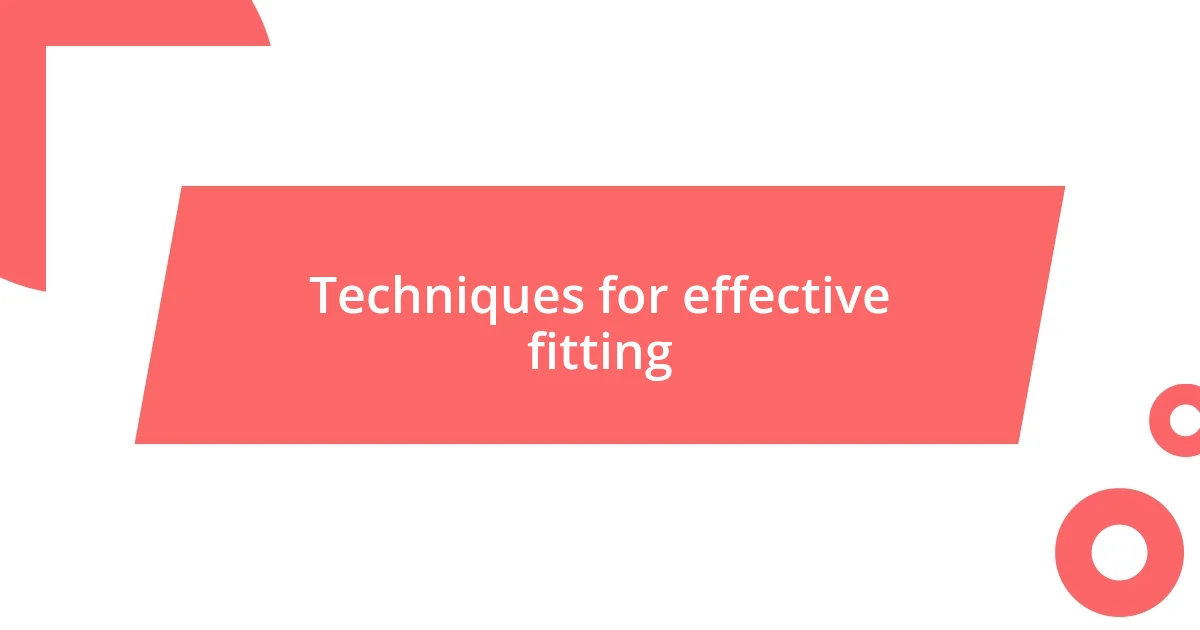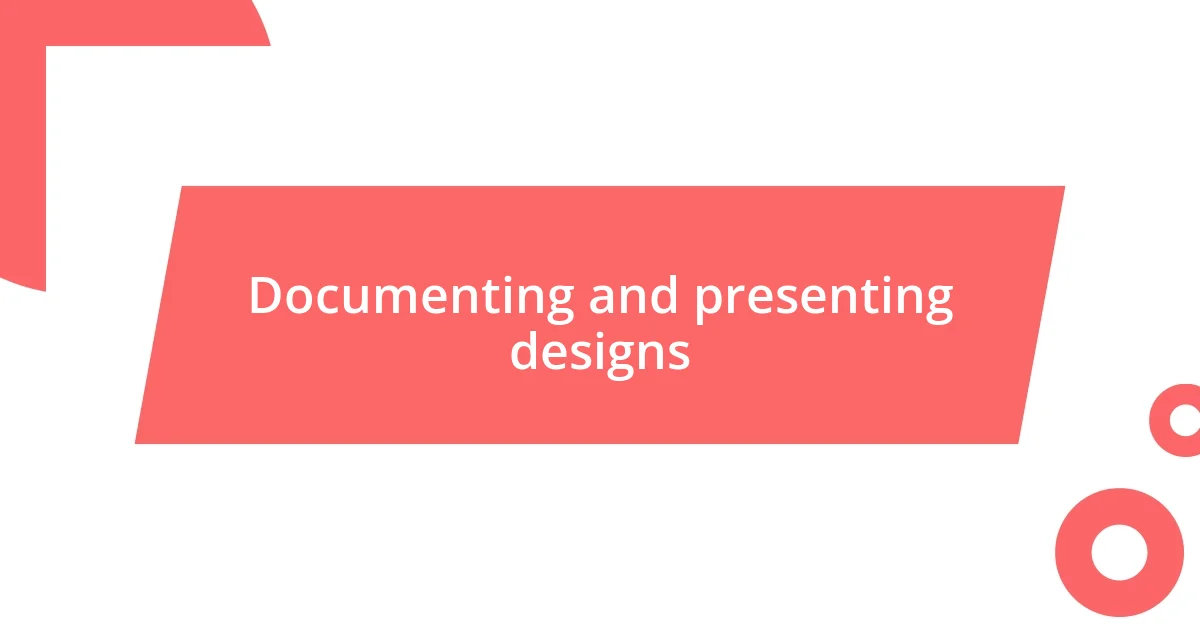Key takeaways:
- Costume design requires a deep understanding of fabrics, historical accuracy, and cultural context to effectively convey a character’s identity and story.
- Collaboration with directors and actors enhances the design process, facilitating creative exchanges and adjustments that improve comfort and performance.
- Thorough documentation, including sketches and notes, allows designers to track their creative process and engage the team meaningfully during presentations.

Understanding costume design basics
Costume design is a vital element in storytelling, serving as a visual representation of a character’s identity. I remember a production where I had to capture the essence of a historical figure; it felt like diving into a time machine, envisioning how each fabric choice might reflect their personality and status. Can you imagine how a simple color can evoke different emotions and signify cultural contexts?
Understanding fabrics is essential, as each material brings its own texture and mood to the character. I once chose silk for a regal character, feeling its smoothness added a layer of sophistication, while a rougher fabric for a peasant character communicated grit and resilience. Have you ever touched a fabric and felt an immediate connection to what it could represent on stage?
Finally, never underestimate the power of accessories—they can transform an outfit and give depth to your characters. I once added a vintage locket to a costume, which not only completed the look but also hinted at a backstory, sparking curiosity in the audience. What little details do you think might change the way people perceive a character instantly?

Researching historical accuracy
Researching historical accuracy is truly a journey into the past. When I was tasked with designing costumes for a Shakespearean play, I spent hours poring over portraits and clothing manuals from the time. It surprised me how much detail was available; I found resources like tailor’s guides and period illustrations that made it feel like I was channeling history through fabric. How often do we overlook these treasure troves of information that can breathe life into our designs?
I also learned the importance of consulting historians or experts in the field. For one project, I reached out to a local historian who specialized in the era I was depicting. The insights I gained were invaluable; they helped me avoid common pitfalls, such as misrepresenting certain styles or colors that were not typical for that time period. Have you ever considered how experts might elevate your work by adding layers of authenticity?
Lastly, I’ve come to appreciate how understanding cultural nuances can inform design choices. While researching for a 1920s piece, it was fascinating to discover how societal changes influenced fashion trends. Incorporating those elements allowed my costumes to tell a deeper story. What aspects of cultural context do you think play a crucial role in shaping your designs?
| Research Method | Outcome |
|---|---|
| Poring over historical documents | Gained detailed insights into specific styles |
| Consulting experts | Avoided misrepresentations, added authenticity |
| Understanding cultural nuances | Created deeper, more meaningful designs |

Selecting fabrics and materials
Selecting the right fabrics and materials can truly elevate a costume from ordinary to extraordinary. I remember a production where I needed to evoke a fairy-like essence for a whimsical character; I selected a lightweight organza that flowed beautifully with every movement. Just watching the actor twirl on stage, the fabric caught the light, creating a magical aura that felt almost tangible. It’s a moment that still resonates with me—how the choice of fabric transformed not just the costume, but the entire performance.
When choosing fabrics, consider both the visual impact and the comfort for the performer. Here’s a quick list of things to keep in mind:
- Weight: Heavier materials can restrict movement; opt for lighter options for active characters.
- Texture: The roughness or smoothness of a fabric conveys strong emotional cues—how do you want your audience to feel?
- Colorfastness: Always check if the fabric will bleed or fade, especially under stage lights.
- Breathability: Keep the actor’s comfort in mind; breathable fabrics are essential for those intense scenes.
- Durability: Some fabrics may fray or wear out quickly during performances; choose wisely to save time on repairs.
I’ve also found that mixing materials can create a unique visual narrative. For instance, pairing a soft velveteen with a glossy satin not only adds depth but also contrasts textures in an unexpected way. It’s details like these that make the costume feel lived-in and authentic. Have you ever played with fabric combinations and discovered something new and exciting about your character?

Creating character through design
Creating character through design is an exciting challenge that allows us to convey narrative and personality visually. One time, when I designed for a modern adaptation of a classic fairy tale, the character’s costume needed to reflect their internal journey. I chose vibrant colors and whimsical patterns to parallel their cheerful yet naive spirit. It struck me how the right design choices can instantly inform the audience about a character’s essence—wouldn’t you agree that color has an incredible power to evoke emotion?
I’m also a firm believer in the significance of silhouette in costume design. For a moody, brooding character, I once opted for sharp, angular lines and heavy fabrics that draped dramatically. This not only added an imposing presence on stage but also helped illuminate the character’s turbulent nature. Reflecting on how shapes and silhouettes can convey emotions makes me wonder—how do you perceive a character’s personality just by their contour?
Lastly, accessories can make or break a character in the world of costume design. In one production, I adorned a heroic character with a distinct pendant that held personal significance to their backstory. This small but vital detail invited the audience to connect with the character on a deeper level. Isn’t it fascinating how a single accessory can weave a richer narrative? Each design choice provides an opportunity to breathe life into characters, allowing them to resonate long after the curtain falls.

Techniques for effective fitting
When it comes to fitting costumes, I’ve found that communication is key. During fittings, I always encourage actors to express how the garment feels on their bodies. I remember fitting a historical dress for a lead actress who was concerned about its weight. After some back-and-forth, we adjusted the hemline and made it lighter, allowing her to move freely while still embodying the character. Have you ever noticed how an actor’s confidence shines when they feel comfortable in their costume?
Another technique I’ve embraced is using a dress form that closely matches the actor’s dimensions. This can be a game-changer in terms of getting proportions right before engaging the performer fully. During one production, I quickly realized that my dress form wasn’t a perfect match for the actress’s unique body type. It prompted us to adapt and make tweaks before the final fitting, ensuring it hugged her curves in all the right places. Have you ever adjusted a form to better reflect a unique character?
Finally, I always advocate for multiple fitting sessions. I tend to arrange several fittings leading up to the first performance to refine the details meticulously. In one instance, after the third fitting, I spotted some bunching in a seam that could hinder movement. Addressing these nuances ahead of time not only enhances the costume’s overall appearance but also boosts the actor’s comfort and confidence. How often do you find that a small adjustment can make a significant impact?

Collaborating with directors and actors
Collaborating with directors and actors is truly a dance of creativity. One time, while working on a contemporary play, the director had a specific vision that included the costumes as a pivotal narrative tool. I remember how we spent hours discussing colors and textures over coffee, refining ideas that complemented the dialogue. Have you ever found that a casual conversation can spark the most brilliant design concepts?
The actors often bring their own insights and experiences into the mix, which I genuinely appreciate. During a rehearsal for a fantasy production, one actor mentioned how certain fabrics restricted his movements during action scenes. By incorporating his feedback, we chose lighter materials, enabling him to fully embody his character. Isn’t it amazing how open communication can lead to unexpected breakthroughs in design?
Additionally, creating trust within this collaboration is essential. I make it a point to reassure actors that their voices matter in the process. In one memorable instance, a shy actress opened up about her discomfort with a costume that felt too revealing. A simple discussion led to a redesign that made her feel empowered rather than exposed. Have you ever witnessed how safety in an artistic space can produce performances that are truly breathtaking?

Documenting and presenting designs
Documenting and presenting designs is a process that I find to be as artistic as the designs themselves. I’ve developed a habit of sketching and taking photos throughout the costume design process, capturing each stage of the evolution. For example, during one project, I compiled a visual journal that showcased everything from initial sketches to the final costumes on stage. This not only helped me track my creative journey but also served as a powerful presentation tool for sharing with the team. Have you ever realized how visual documentation can transform your design narrative?
In addition to visuals, I believe in writing detailed notes about fabric choices and design inspirations. I recall an instance where I documented the significance of a specific texture in a historical drama, noting how it resonated with the character’s backstory. By sharing these insights, I engaged the actors and director on a deeper level, enhancing their connection to the costumes. Isn’t it fascinating how written elements can enrich the overall understanding of a piece?
When it comes to presenting designs, I always try to keep it interactive. During design meetings, I love showcasing swatches and small fabric samples while inviting feedback. Just the other day, while presenting costumes for a musical, I spread out the vibrant materials on the table and encouraged everyone to feel them. This tactile experience not only sparks conversations but also creates excitement about the designs. Have you ever noticed how engaging the senses can elevate the discussion around your work?












